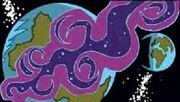- You may be looking for Short Trips: The Solar System.
The solar system was a star system centred on the star called Sol in the galaxy known as the Milky Way or Mutter's Spiral.
History
The First Doctor was unfamiliar with the solar system prior to his departure on Gallifrey. However, his granddaughter Susan Foreman learned of its existence and that of Earth in her spatial cartography lessons. (AUDIO: The Beginning)
During the time of the Silurians and Sea Devils, a rogue planet approached the orbit of their homeworld, Earth. The Third Doctor told the Silurians that instead of drawing off the Earth's atmosphere as their scientists had previously calculated, it became the Moon. (TV: Doctor Who and the Silurians)

A cosmic cloud appeared near Earth and Mondas shortly before the Moon was formed. (COMIC: The Prodigal Returns
Mondas, which originally orbited the Sun at the same distance as Earth, was also affected by the rogue planet. (COMIC: The Prodigal Returns) When it arrived, Mondas left orbit and wandered out further into the solar system. (TV: The Tenth Planet)
Circa 12,000,000 BC the Time Lords placed Planet 5 in a time loop, in effect destroying it. The Fendahl, which came from the Fifth Planet and which the Time Lords had intended to destroy, may have destroyed life on Mars on its way to Earth. (TV: Image of the Fendahl)
- An asteroid belt somehow resulted from the time looping of the fifth planet.
In the mid-20th century, the humans of Earths began to explore their solar system via probes and, tentatively at first, with manned missions. The Moon was the first object in the solar system to be visited by humans — at least, according to the official historical record. (TV: Blink, et al)
Piloted by the Cybermen, Mondas returned to the solar system in 1986. (TV: The Tenth Planet)
Later, missions to Mars occurred. Accounts differed as to whether the first human landing on Mars was in the 20th century, (TV: The Ambassadors of Death, etc) or in 2041 or 2058. (TV: The Waters of Mars)
Circa 2009, Earth was forcibly relocated to the Medusa Cascade by the Daleks. (TV: The Stolen Earth) The relocation of Earth seemed to have no lasting effects on the solar system; even Earth's Moon remained in place until the Tenth Doctor and his companions returned Earth to its proper position. (TV: Journey's End) The end result of the incident was that the general populace of Earth were now aware of the existence of alien life (TV: Children of Earth: Day One, et al), ushering in the planet's increased presence in interstellar affairs from the 21st century onward. (TV: The Christmas Invasion, Everything Changes, et al)
In 2009, the Time Lord homeworld, Gallifrey, briefly materialised near the planet Earth, before being returned to its proper location. (TV: The End of Time)
Around 2089, Susie Fontana Brooke, the granddaughter of Captain Adelaide Brooke piloted the first ever lightspeed ship from Earth to Proxima Centauri. Soon after that, the human race started colonising other star systems. (TV: The Waters of Mars) According to the Third Doctor, this happened after humans had "sacked" the solar system. (TV: The Mutants)
The planetoid or moon Voga entered the solar system some time after the construction of the Nerva Beacon. (TV: Revenge of the Cybermen)
In the 30th century, a lurgy swept through the solar system. (PROSE: From Wildthyme with Love)
Prior to 4000, Mavic Chen assumed the position of Guardian of the Solar System. Chen's secret allies, the Daleks, at the same time proposed to conquer the solar system. (TV: Mission to the Unknown, The Daleks' Master Plan)
In 5000, the Fourth Doctor destroyed Saturn's moon, Titan in order to destroy a colony of the Swarm. (TV: The Invisible Enemy)
Circa 2,000,000, the Time Lords transported the entire solar system using a magnetron. (TV: The Mysterious Planet)
In the 57th segment of Time the last humans left on Earth evacuated the planet because of the increasing danger that it would fall into the Sun. They fled to planets such as Refusis II and Frontios. (TV: The Ark, Frontios) The now uninhabited Earth was preserved by the National Trust and over the billions of years following was restored to a 'classic Earth' before it was finally destroyed by the expanding sun in the year 5.5/Apple/26. (TV: The End of the World)
Cultural significance
After a long struggle both on their own planet, Earth, and with other sentient species in the system, humans became the region's dominant species and led several different inter-planetary governments. (TV: The Daleks' Master Plan, The Monster of Peladon, Bad Wolf) Indeed, the solar system's significance was largely tied to the fate of humanity, since humans became one of the universe's longest-lived species, continuing on until the universe itself was entering its final stage of development. (TV: The End of the World, Utopia)
Behind the scenes
The term solar system can also be a simple synonym for star system in DWU fiction. However, in most instances, solar system—even though uncapitalised—refers to "the star system bound together by Sol".
The Waters of Mars gives two contradictory figures for when humanity first landed on Mars. The first is when the Tenth Doctor refers to the colonists that founded the Bowie Base One colony in July 2058 as the "very first humans on Mars", and the second is an on-screen obituary of Adelaide Brooke (captain of the Bowie Base One colonists), which states she was part of a three-person team on Mars when she was 42 (i.e. in 2041). Neither of these points are especially reconcilable with The Ambassadors of Death.
